Mana ramp comes in a lot of different flavors in Magic: The Gathering (MTG). Green is the best individual color in the color pie at performing this task, as it provides ample ways to put extra lands onto the battlefield from your hand or deck as well as efficient ways to add extra mana to your mana pool via creatures, enchantments, and artifacts.
White is the second best mana ramp color, though its ramp options are either contingent on you being behind other players in terms of land count or your opponents fulfilling a specific condition in order to ramp or accelerate your mana.
Red is the best mana acceleration color, giving out huge one-time bursts of mana for a comparatively low up-front investment. Black and blue typically get the scraps left over from the other 3 colors, resulting in a lot of varied card designs that are often mechanically unique.
These strengths and weaknesses, whether comparing mana ramp, removal, card drawing, or other gameplay mechanics, are what makes the color pie such an integral part of the MTG experience. You can’t be the best at everything by playing a single color, because there are clear boundaries on the types of card designs each receives.
You can, however, start to blur the lines between each color’s identity once multicolor cards enter the conversation.
How Does Multicolor Mana Ramp Work in MTG?
Multicolor (also referred to as gold) cards can vary pretty wildly when it comes to mana ramp for a few reasons:
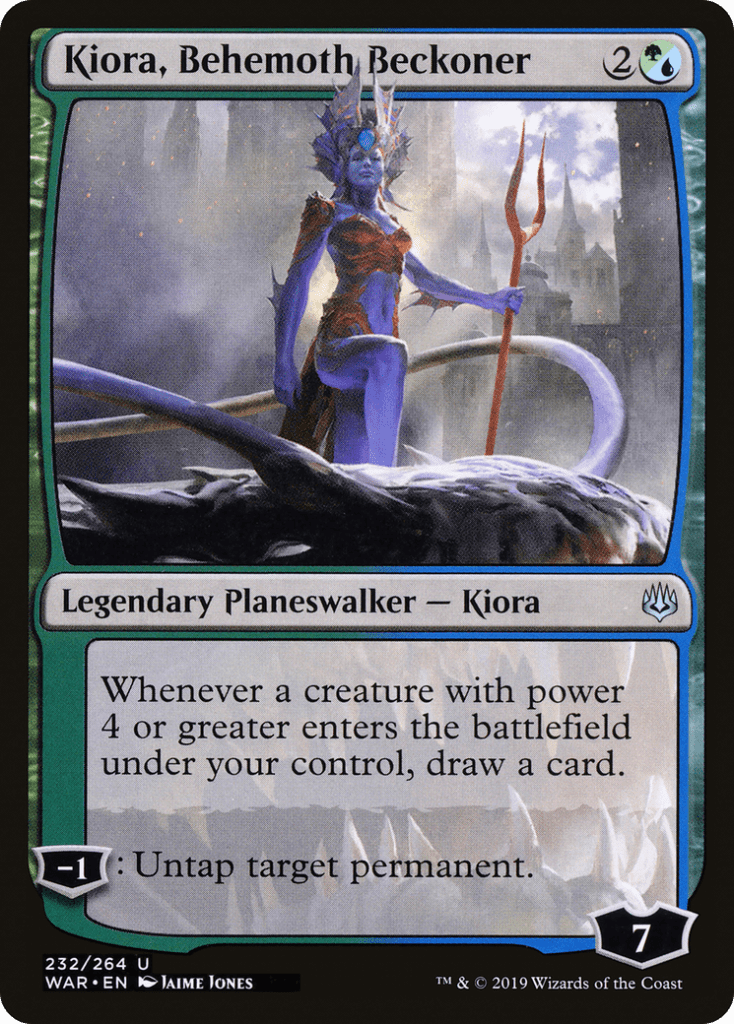
- The identities of each color on a multicolor card need to come through to some extent
- The more colors a card requires in its mana cost, the more powerful its effect tends to be
- The power level of mana ramp fluctuates wildly from card to card, especially within multicolor options
While those last two points seem to work against each other at first glance, the fact of the matter is that there just aren’t as many multicolor cards in the MTG card pool as single color cards.
Between this and the philosophy that multicolor cards can draw upon multiple parts of the color pie for their effects, the roles of multicolor cards are somewhat more malleable than those of their monocolor counterparts, as recently demonstrated by Wizards of the Coast when designing the colleges of Strixhaven.
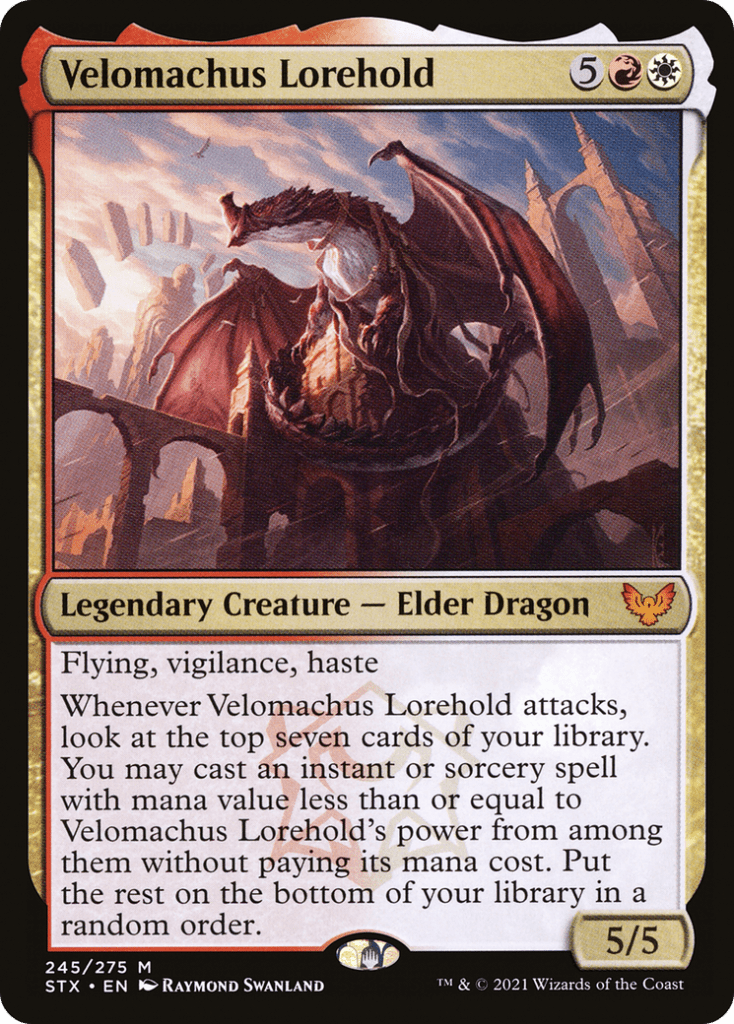
For example, Lorehold’s college (red/white) leaned into the idea of impulsive discovery rather than traditional Boros aggro strategies, featuring cards that allowed you to cast spells from the top of your library and retrieve cards from your graveyard. Aggressive small creatures were still present, but they weren’t the sole focus of this color pair for once.
This blend of red’s impulsiveness and white’s recursion was both novel and well received, and it highlighted something more important to Magic as a whole – there’s a lot of unexplored design space within multicolored cards.
Why does this tangent matter when looking at multicolor mana ramp, you ask?
Because mana ramp is a sizable percentage of multicolor’s unexplored design space.
This was a surprising revelation when researching Magic’s card database, but upon further reflection, I realized there are only a few multicolor cards I generally turn to when I want access to extra or stronger mana ramp effects, and most fall within a couple color pairs (Simic and Selesnya).
Some color combinations simply don’t have any mana ramp worth playing at all, either forcing you to consider extremely mediocre options or exclusively rely on single color cards and mana rocks to get the job done:
- Dimir (Blue/Black)
- Boros (Red/White)
- Orzhov (Black/White)
- Esper (Black/Blue/White)
- Grixis (Blue/Black/Red)
- Abzan (Green/Black/White)
- Sultai (Black/Green/Blue)
- Temur (Green/Blue/Red)
- Most 4-color groupings
That doesn’t mean all other color combinations have amazing ramp options though – many can only offer situationally powerful cards. This doesn’t make them unplayable, but it does mean that they are only going to provide specific or supplemental support at best.
Traits of Good Multicolor Mana Ramp Cards
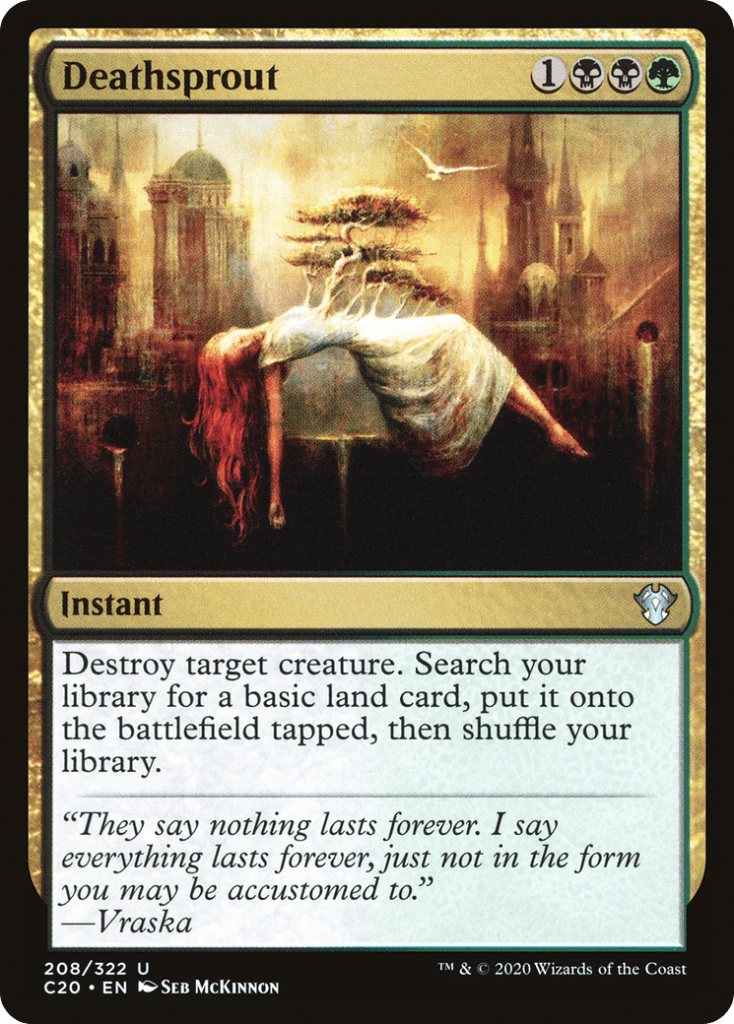
Playable mana ramp in Commander almost always needs to have at least 2 of the following traits to justify its inclusion in a deck:
- Low mana cost (ideally 4 or less, lower usually being better)
- A permanent impact on your board
- A sizable mana ramp or acceleration payoff
Most multicolor ramp spells simply fall short of their monocolor brethren under these criteria for a couple reasons. First, multicolor cards that don’t have hybrid mana symbols in their cost will cost a minimum of 2 mana, more if they include more than 2 colors.
Second, this increased cost often means multicolor spells can’t be cast as quickly or easily as a monocolor ramp spell – especially if you aren’t able to assemble multiple colors of mana due to a poor opening hand or early disruption to your mana.
Since the entire point of playing a mana ramp card is to be able to play more expensive spells as quickly as possible, any variable that can slow down your ability to take advantage of these pivotal spells on curve can cause a surprising amount of harm in a worst case scenario.
For a practical example, why would you play a card like Llanowar Dead when you could play Birds of Paradise instead? The Birds come down a turn earlier, require fewer colors to play, and generate any color of mana when they tap instead of just black.
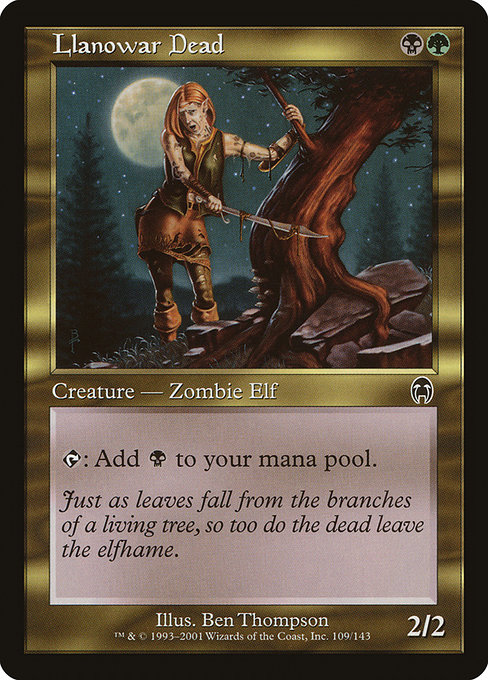

The short answer: you wouldn’t. You also wouldn’t play Llanowar Dead over Three Visits as Three Visits only requires green mana, it can fetch lands that tap for multiple colors, and its ramp effect isn’t tied to a creature that will likely disappear after your game’s first board wipe.
Since there are so many strong monocolor mana ramp options and mana rocks to choose from across Magic’s history, a multicolor card has to really bring something special to the table to stand out, especially if green is in its color identity. Even then, it may still not make the cut, depending on the needs of your deck and its strategies.
That said, sometimes you need that extra ramp effect, niche or otherwise, to strike the right balance. The cards discussed below are not an exhaustive list of possibilities, but they are the ones that will have the most generic appeal for players and decks across the Commander format.
Best Selesnya Mana Ramp Cards (Faeburrow Elder, Karametra, God of Harvests, Mirari’s Wake, Selvala, Explorer Returned)

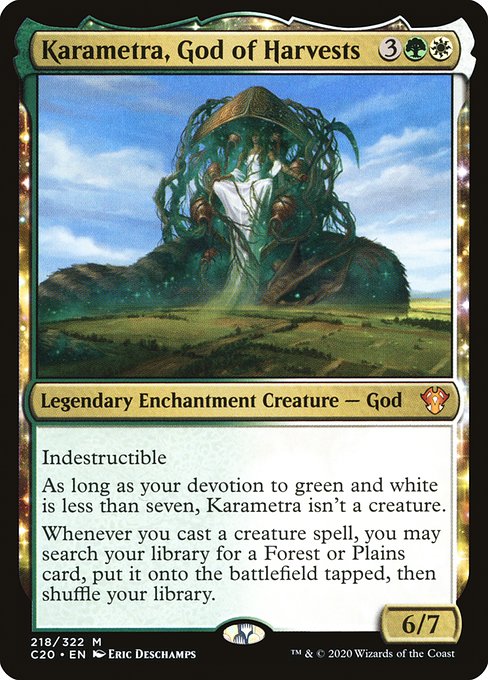


Weirdly, when you put the two best mana ramp colors together, you struggle to find many playable options. Those that are available, however, are absolute powerhouses once you get them going.
Faeburrow Elder and Selvala, Explorer Returned are the most reliable of Selesnya’s mana ramp options due to their low mana cost, but both also need to tap to generate mana, so you’ll need a way to give them haste to access their mana generation on the turn you play them.
From here, which you play depends a lot on your deck. Faeburrow Elder can generate a mana for each color among permanents you control, doing a solid impression of Bloom Tender despite requiring an additional white mana to put on the battlefield.
The tradeoff for that extra cost is that it also gets +1/+1 for the colors among your permanents. At worst, this means you have a 2/2 that taps for 1 white mana and 1 green mana, which is serviceable. At best, you can have a 5/5 for 3 that generates 5 mana or can attack and block well. Either way, very solid, though usually best in 4+ color decks.
Selvala, Explorer Returned offers a group hug mechanic with a bit of gambling mixed in. In a perfect world, you play it on turn 3, tap it for 4 mana and 4 life on turn 4, and play an 8-drop. In reality, you’ll probably see 2-3 mana on average while giving everyone at the table extra cards. Still an incredible rate for what you get, and a solid inclusion for many 2+ color decks.
Karametra, God of Harvests costs 5 mana to put into play, which is normally too rich for my blood when I need fast mana ramp. Fortunately, it is indestructible, and the difficulty of turning it into a creature is actually a blessing much of the time, dodging nasty removal spells like Path to Exile and Toxic Deluge until you’ve gotten your mileage.
That mileage comes in the form of stapling a superior Rampant Growth to every creature spell you cast. Doesn’t even have to resolve – if it touched the stack by being cast, you’re getting a Plains or Forest of your choice. This includes shocklands, triomes, tango lands, or any other land that has these basic land types, so mana fixing becomes trivial very quickly.
Sometimes you don’t even want to jump through the simplest of hoops to reap your rewards though. And that’s where Mirari’s Wake comes in. Once a staple, still a casual favorite, the power of this old 5 mana enchantment is undeniable. Doubling your mana is already good, but giving all your creatures +1/+1 really puts it over the top – especially in go wide strategies like token decks.
Best Azorius Mana Ramp Cards (Rasputin Dreamweaver, Rasputin, the Oneiromancer)
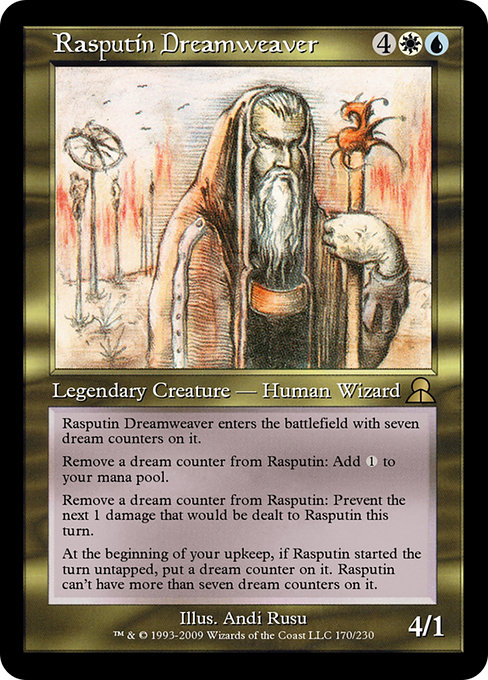
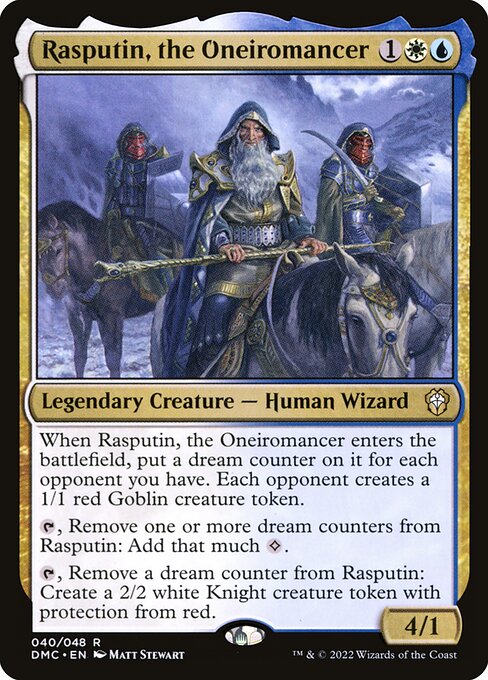
The original version of Rasputin Dreamweaver from Legends is effectively an efficient mana battery. Pay 6 mana now, get up to 7 mana either immediately or on on a later turn.
While not a unique design in itself (each individual color got its own mana battery, and blue would later receive Iceberg in Ice Age), this is a unique space for an Azorius card, and it has been efficient enough to allow Rasputin to see fringe play for years in Commander – assuming you can find a copy.
When Dominaria United came around, there was a lot of tie-in with Legends thanks to the insertion of cards from that set into collector booster packs, and Wizards took this a step further by reimagining several older Legends legendary creatures. Among them was a reimagined Rasputin in the form of Rasputin, the Oneiromancer.
In exchange for being much easier to cast at 3 mana, you receive a dream counter for each opponent you have instead of a fixed amount, and you have to tap to remove the counters for mana, slowing this iteration down considerably.
While giving each opponent a 1/1 is an annoying price to pay for this, it really isn’t a big deal in the grand scheme of things, as you’ll effectively have access to a one-time boost of 3 mana most of the time. Jumping from 3 mana to as much as 7 on turn 4 is huge, and if you don’t need quite that much mana, the ability to make 2/2s later on is also solid.
Best Rakdos Mana Ramp Cards (Burnt Offering, Prosper, Tome-Bound)
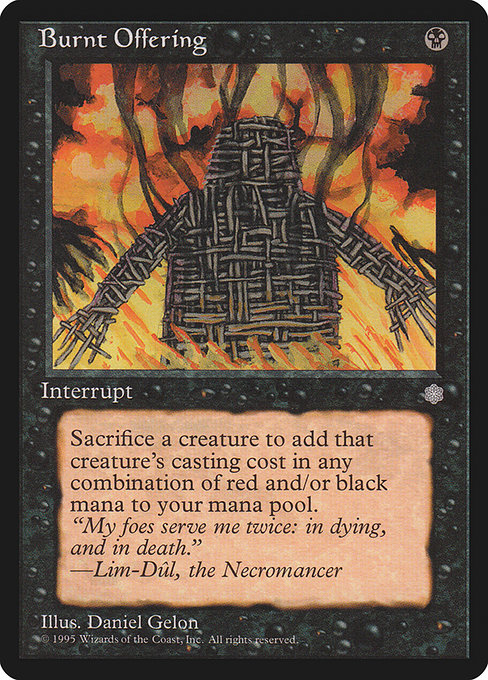
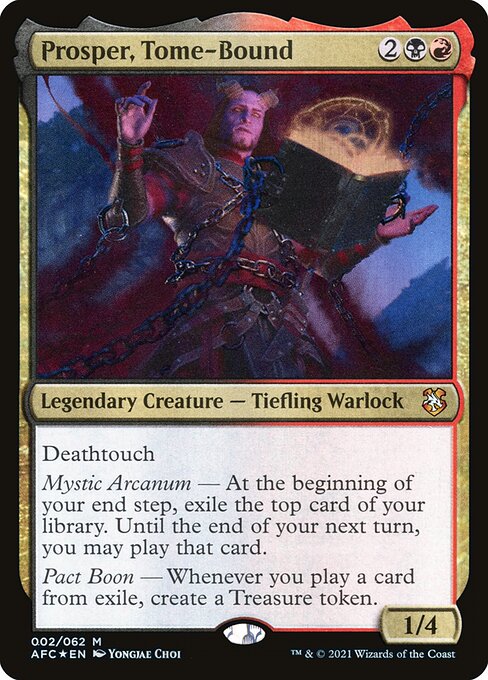
Burnt Offering is another take on Sacrifice, but offering you your choice of 2 colors of mana in any combination you wish. This is a very Rakdos design that showcases black and red perfectly, and it’s surprisingly unique within Magic’s card pool.
As with Sacrifice, Burnt Offering is great with cards that have high mana values that you can play on the cheap, such as those with Affinity or those that cost substantially less if you fulfill a certain condition, like Emrakul, the Promised End, Avatar of Fury, or Avatar of Woe.
Prosper, Tome-Bound requires considerably more setup to use optimally, but if your deck is already playing a lot of cards that let you play cards from exile, the value it generates from its Treasure tokens can be absolutely silly.
Frequently, you’ll even be able to chain several cards together via spells like Light Up the Stage, Jeska’s Will, Praetor’s Grasp, and Opposition Agent, which when used in tandem with cards like Birgi, God of Storytelling or Storm-Kiln Artist, can transition you from pretty much any board position to the dominant threat.
This snowballing capability can make Prosper an excellent card both in the command zone and in the 99 of many decks playing Rakdos colors. It also fuels itself by giving you access to extra exiled cards in a pinch, so even if you don’t have other cards to play with it, you’ll almost always receive some value before it gets killed off.
Best Gruul Mana Ramp Cards (Atalan Jackal, Dire-Strain Rampage, Road // Ruin, Overabundance)
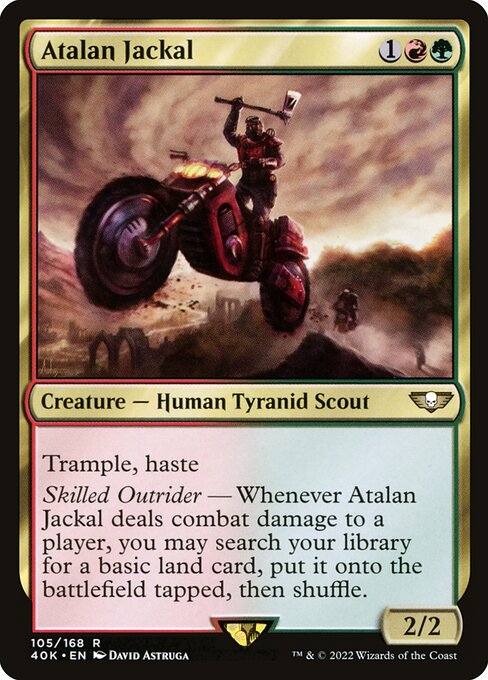
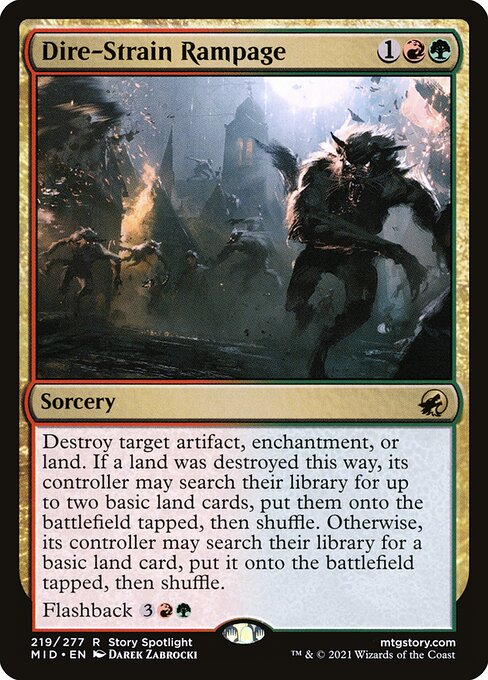
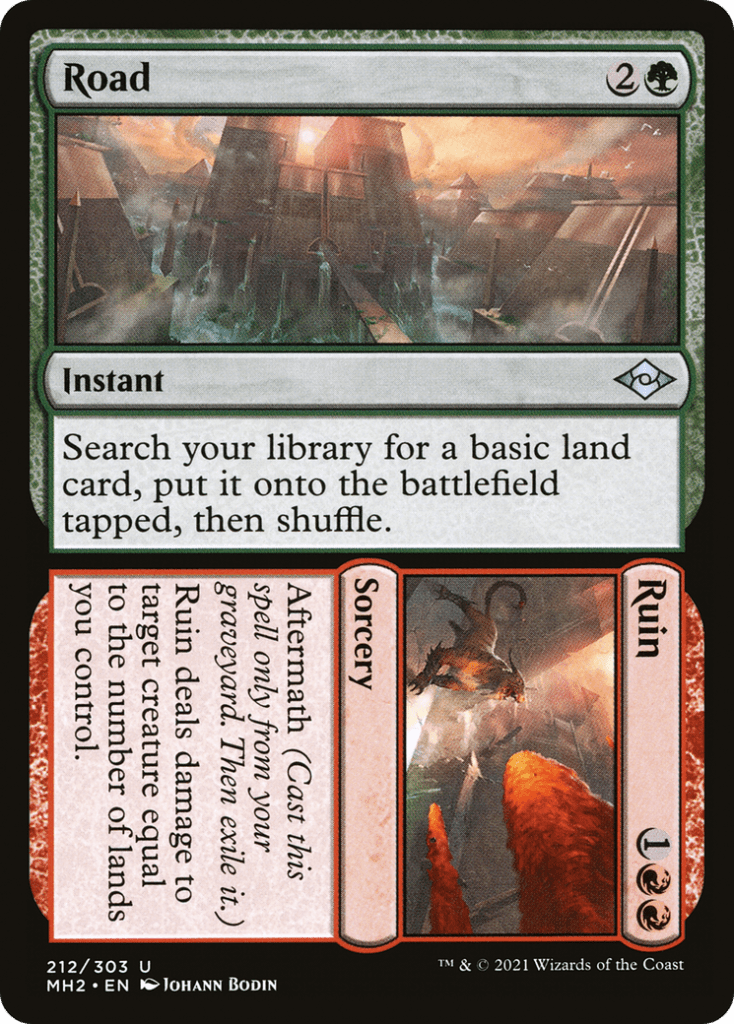

Gruul mana ramp has a surprising tendency to be mediocre (Domri, Anarch of Bolas) or highly situational (Xenagos, the Reveler) despite its access to green, but recent sets have actually brought some comparatively good options to the table that are actually worth considering for a wide selection of decks.
The first of these is Atalan Jackal, an underappreciated gem from the Warhammer 40,000 Commander decks. A 2/2 with trample and haste isn’t amazing for 3 mana, but the fact that it fetches a basic land by doing combat damage to an opponent is, especially in the early turns of a game when boards might still be devoid of blockers.
On later turns, Atalan Jackal can also still have value, as it is a good follow up to a board wipe to get some extra value while rebuilding. The fact that its ability to ramp is also repeatable is also very solid, especially if you can find a way to give it double strike so it hits twice per attack instead of once.
Dire-Strain Rampage takes a different approach, offering you a lot of flexible removal options in addition to the opportunity to use it as a less efficient Harrow. The fact that it has Flashback is what really takes it over the top for me, as it forces opponents to play around it while giving you the option to ramp more if needed.
Road // Ruin doesn’t look especially impressive at first glance, but being able to ramp at instant speed, even for 3 mana, is pretty underrated as it allows you to keep mana up to play other instants when you want to keep your options open.
The Aftermath side isn’t horrible either. 3 mana is admittedly a lot to ask for spot removal, but you should have at least 4 lands by the time you want to use that side of the card, which will take out a lot of dangerous creatures when the need arises.
Not all of Gruul’s best mana ramp options are found in newer sets, however. Overabundance is an efficient group hug piece that comes with the cost of 1 life for each land your opponents tap for mana. Early game, nobody’s going to bat an eye at losing 10-15 life in exchange for extra mana over the course of a couple turns.
Later on, however, this can choke manabases in a big way, forcing players to rely on their mana rocks and mana dorks to play their spells instead of their lands. If they don’t have them, then they’ll just have to wait for someone to remove your enchantment.
Just remember that Overabundance can do the same to you when building your deck – having some nonland options to generate mana or a couple free spells to take out enchantments can go along way toward keeping you from accidentally locking yourself out of the game.
Honorable mentions for Meria, Scholar of Antiquity and Wild Cantor, which while good, require specific types of decks to truly shine. Meria can generate an absolute ton of mana in an artifact deck, and while this isn’t something Gruul is known for, the fact that this creature can be your commander may get more people to explore the possibility.
Wild Cantor is another in a line of creatures that serve as a pseudo Lotus Petal. While most likely to see play in cEDH, I’ve seen enough shenanigans with cards like Enduring Renewal to respect the combo potential Wild Cantor brings to the table too.
Best Golgari Mana Ramp Cards (Belbe, Corrupted Observer, Culling Ritual, The Gitrog Monster)



Golgari is another color combination that just hasn’t leaned into mana ramp as much as I’d have expected by now, boasting the fewest playable options out of any color pair featuring green. The options it does bring to the table are quite interesting and surprisingly powerful once you see them in action though.
Of these 3 cards, Belbe, Corrupted Observer sees the least play by a wide margin, which is really surprising. Giving your opponents access to an extra 2-4 mana during their second main phase can definitely be problematic if your opponent is holding a powerful card or two, but in exchange, you can snag 4-6 each turn, as no mana is given out when you lose life.
The way Belbe’s ability is worded actually reminds me a lot of cards like Edric, Spymaster of Trest. It reads like a group hug card, as it gives your opponents something they want for minimal effort, but incentivizes not attacking or targeting you to get that value. Cards like this do far heavier lifting in a game than anyone expects until it’s too late to address it.
Best of all, you can actually set yourself up so that you get to use Belbe before your opponents can. It doesn’t have to tap to use its ability, and it doesn’t care how your opponents lost life when giving out extra colorless mana. Heck, an errant Zulaport Cutthroat trigger from an opponent will satisfy Belbe’s conditions!
Definitely a very strong card in and out of the command zone for Aristocrats strategies, or any other deck that can consistently whittle away at multiple life totals each turn.
Culling Ritual is a board wipe that I have to remember hits all nonland permanents of mana value 2 or less instead of just artifacts, which is what it historically clears due to the best mana rocks all meeting that criteria.
While mileage is going to vary based on the power level of the decks at the table, the general rule of thumb is that the more optimized your Commander pod’s decks are, the more value you’re going to get out of this card. Trading 4 mana for 6-12 while also setting your opponents back is insanely good, and breaking even is also quite solid if you lost no permanents.
The Gitrog Monster probably needs no introduction if you’ve been playing the Commander format for any length of time. The ability to play an extra land each turn means that you’ll still be able to get ahead when sacrificing lands, and the fact that your lands turn into new cards when they are put into the graveyard from anywhere ensures you’ll always have plenty to play.
The “from anywhere” clause on The Gitrog Monster is what really puts it over the top. Golgari has a lot of self-mill effects that will trigger this card drawing ability from your deck, and between Crucible of Worlds, Ramunap Excavator, or Regrowth effects, you can easily treat your graveyard as an extension of your hand when needed.
Once you add red or blue into the mix, your available options to abuse The Gitrog Monster skyrocket in decks dedicated to lands or recursion such as those headed by Lord Windgrace or Muldrotha the Gravetide. If you haven’t given this card a spin yet, I highly recommend it, as decks designed to take advantage of its talents can often win the game with ease if it sticks.
Best Simic Mana Ramp Cards (Growth Spiral, Joint Exploration, Kinnan, Bonder Prodigy, Uro, Titan of Nature’s Wrath)
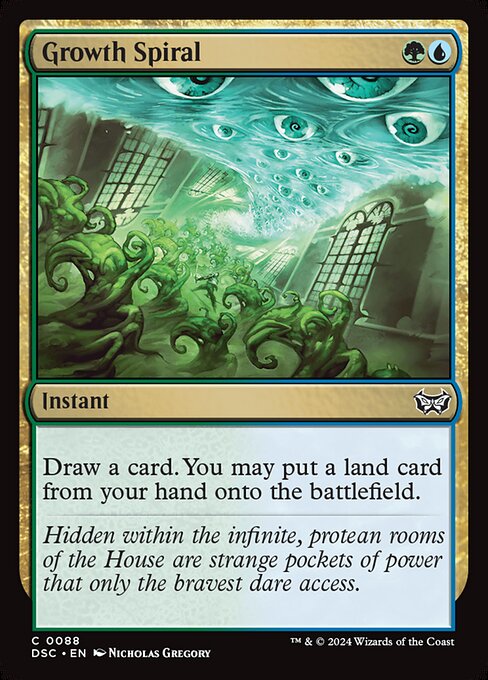
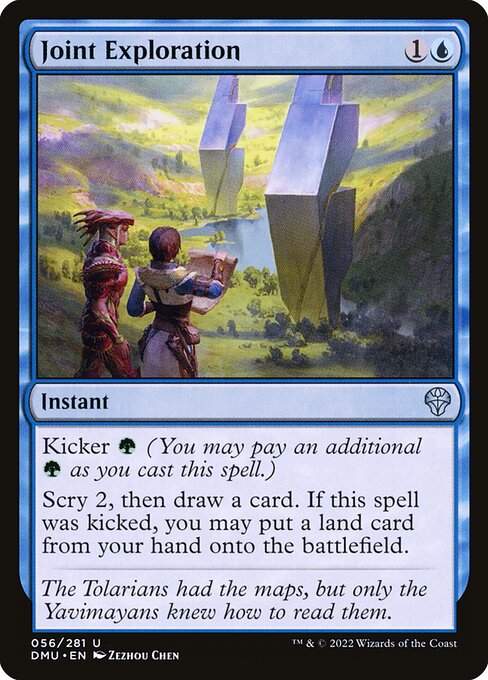

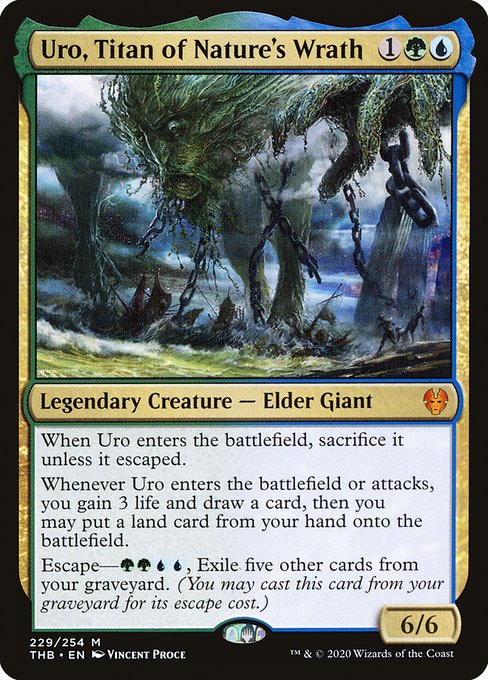
Simic decks have an absolute embarrassment of riches when it comes to potent mana ramp options, frequently pairing efficient mana ramp with card drawing effects at low mana costs.
The tradeoff for ramping this way when compared to mono green mana ramp is that your ramp usually comes from the opportunity to play extra lands in your hand or that you draw rather than searching your deck for them. Still very powerful most of the time, and even if you don’t have a land to ramp into, you usually still walk away with an extra card.
Growth Spiral is especially good in this regard because it can be played as an instant. With access to blue, this lets you keep up the threat of counterspells, removal, or something nasty with Flash, and if you don’t end up needing to use any of that, you get to play this at the end of an opponent’s turn and untap further ahead in cards and/or mana.
Joint Exploration takes this idea step further, giving you the choice of an instant speed Preordain for 2 mana (which while inefficient, lets you look at up to 3 new cards), or for the addition of a green mana, staple on Growth Spiral‘s ability to drop another land onto the battlefield – a package deal that is well worth the cost of admission.
If you want still more out of your 3 mana investment, Uro, Titan of Nature’s Wrath lets you draw a card, gain 3 life, put a land onto the battlefield, and then do it again later in the game for 4 mana and 5 other cards in your graveyard via the Escape mechanic.
No wonder it was banned in Standard, Pioneer, and Modern – that is some absurd value.
Kinnan, Bonder Prodigy takes a different approach than the 3 previous entries, electing to instead turbocharge your mana dorks, mana rocks, and any other nonland permanent you control that makes mana by enabling them to produce an additional mana of any type they produce.
On its own merits, this would already be insanely good, as enabling a Mana Crypt that taps for 3 colorless mana, a Basalt Monolith that can go infinite with Kinnan on turn 3, or a Birds of Paradise that taps for 2 mana of any color is ridiculous value. But the fun doesn’t stop there – Kinnan also gives you a place to dump all that extra mana too.
That’s right, for a mere 7 mana, you can put the best creature in the top 5 cards of your library straight onto the battlefield. No casting, which evades most counterspells, and the only limit to the number of times you can use it is the mana you produce. Definitely not a fair card, especially if you build around it as a commander.
If you’re looking for additional options for mana ramp in Simic colors beyond the really busted stuff, here are a few additional cards I can recommend:
- Coiling Oracle: The original Growth Spiral design, this card looks specifically at the card you draw before dictating what you can do with it. Simply drawing a card when playing or blinking a cheap creature is already pretty good – getting to sneak some extra lands into play is just a bonus.
- Kiora, Behemoth Beckoner: At 7 loyalty, you’ll almost always get to untap a land for several turns, which can enable some explosive plays with lands that tap for multiple mana. The fact that you also get to draw a card when creatures with 4 or more power enter the battlefield makes Kiora a great pick for creature focused decks worried about running out of steam.
- Risen Reef: On its own merits, this card just looks like a worse, but still playable Coiling Oracle. In a deck with multiple Elementals or Changelings, Risen Reef will simply put you too far ahead of your opponents to be stopped. Should one appear on an opposing battlefield, kill it on sight without asking questions.
- Thrasios, Triton Hero: This card will win almost any attrition war if the board hits a gridlock. 4 mana is a lot to pay for scry 1, then draw a card or play a land, but when you have nothing better to do with your mana, this card will pull you far ahead at a surprisingly quick pace.
Best Izzet Mana Ramp Cards (Galazeth Prismari, Prismari Command, Storm the Vault)
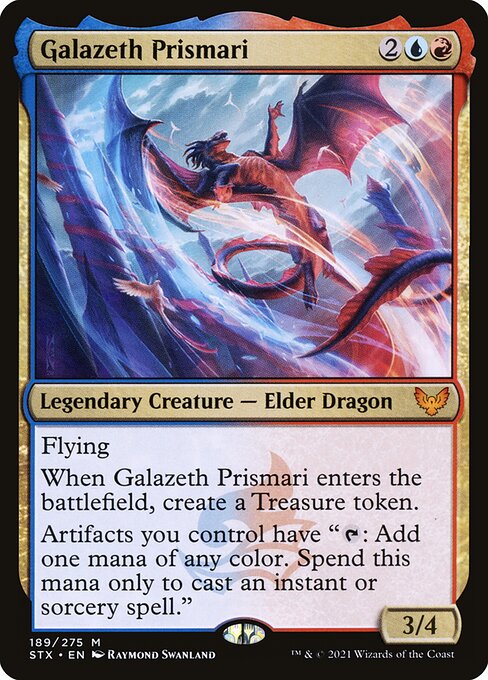

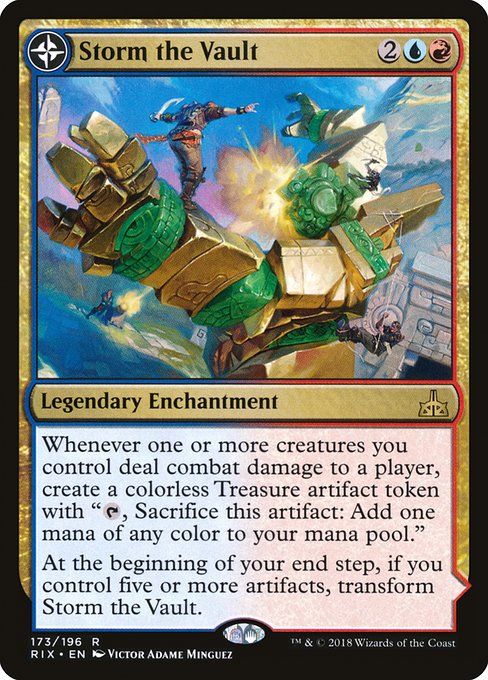
Izzet doesn’t have a lot of mana ramp options, and while there are some that have niche appeal like Dalakos, Crafter of Wonders, the best cards with universal appeal lean on the acceleration provided by Treasure tokens to fix and generate mana.
Prismari Command, while the least potent of these cards by mana acceleration standards, offers the most flexibility as a modal instant. Being able to take out a weak or near-dead creature, destroy an artifact, or do a Faithless Looting impression are all solid abilities to pair with making a Treasure, giving you an effective Lotus Petal to push a bigger play next turn.
Galazeth Prismari takes Treasures (and other artifacts) a step further by letting them act as permanent mana rocks for instants and sorceries, both of which receive a lot of support from cards in the Izzet card pool. There’s also nothing stopping you from both tapping and sacrificing treasures for mana on the same turn, which can fuel extremely powerful spells.
Both can also be useful for setting up either side of Storm the Vault, an enchantment that rewards creatures for doing damage by giving you treasures. Once you have 5, it flips into Vault of Catlacan, a land that taps for any color or adds a blue mana for every artifact you control like the infamously banned land, Tolarian Academy.
While each of these cards can be of use to multiple Izzet strategies, the latter two really tend to thrive in artifact-centric decks with big instant and sorcery payoffs. Prismari Command is just a great general value card that offers a little mana acceleration when you need it, so it’s the card most blue/red decks will turn to first when looking for another way to make mana.
Best Bant Mana Ramp Cards (Chulane, Teller of Tales, Derevi, Empyrial Tactician, Wargate)
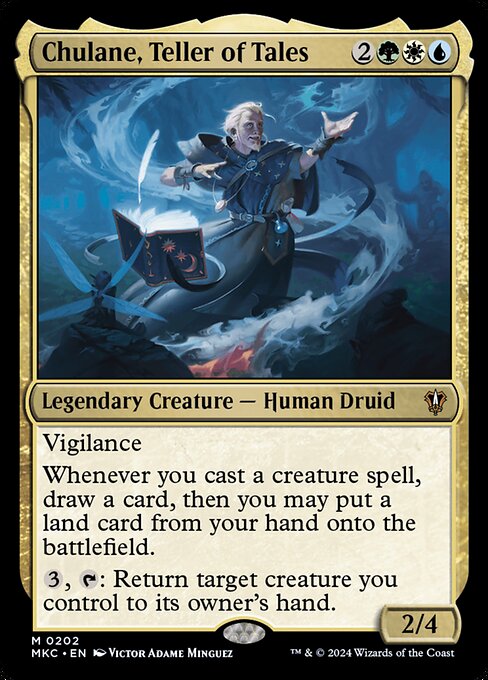


Bant’s most universally appealing mana ramp cards are all incredibly dangerous in different ways, to the point where each of the legendary creatures are popular commanders in higher power Commander pods.
Derevi, Empyrial Tactician has done an impressive job of holding its position in the format for years. Its ability to circumvent commander tax at instant speed makes it incredibly difficult to hit with lasting removal over the course of a game, and the fact that it can pop in at instant speed to untap your best permanent or tap its biggest threat has screwed up more than a few carefully orchestrated plans.
Once Derevi is on the battlefield, the common strategies involving it are either to go wide with a lot of evasive creatures to generate absurd amounts of mana from lands and mana rocks or to start tapping things down in tandem with Stax cards like Stasis and Winter Orb to create an incredibly tight stranglehold over the board.
Chulane, Teller of Tales is a little less toxic, but no less brutal once it gets going. The sheer value you can generate from creatures that enter the battlefield, drawing cards, and playing extra lands snowballs at an incredible pace, which can make even a round or two of Chulane’s shenanigans too much for the rest of the table to compete against.
If neither of these cards fits your deck’s game plan, however, Wargate almost certainly will. By tacking an extra 3 mana onto the cost of any permanent in your deck, you can simply put it onto the battlefield. No wasting time putting it in your hand like a conventional tutor, and for 3 mana, you simply get the best land in your deck as an extra land for the turn.
With options like Gaea’s Cradle, Ancient Tomb, Serra’s Sanctum, and Lotus Field in Bant’s arsenal of lands, an early game can spiral out of hand quite quickly in the right decks, and if a land isn’t required, Wargate can simply fetch a more powerful threat later on to close the game instead.
Best Naya Mana Ramp Cards (Trace of Abundance, Winter’s Night)
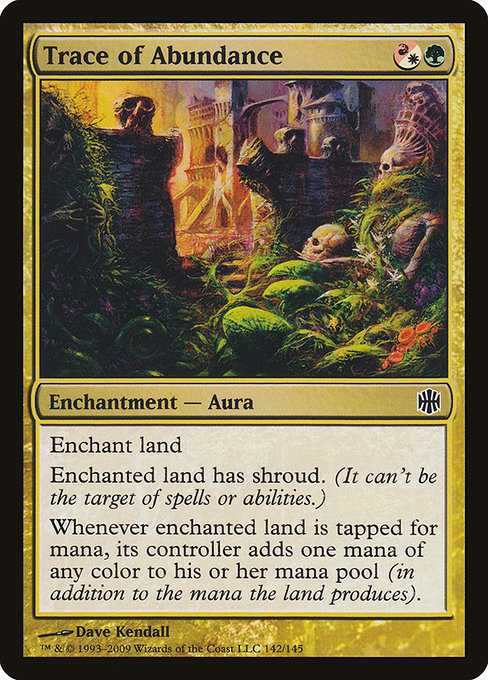
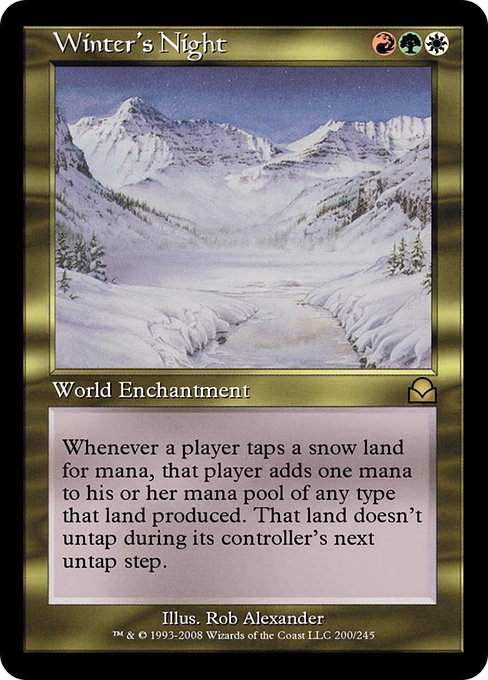
Fertile Ground isn’t a mana ramp option that green decks clamor for since Wild Growth and Utopia Sprawl tend to do the same job for less mana, but Trace of Abundance does something none of these lands can’t by protecting your best land from spot removal effects like Strip Mine, Vindicate, and Beast Within while ramping you – often on the turn you play it.
While enchantments are fairly easy to destroy, especially with cards similar to the ones above, it adds an extra step to the process for your opponents barring mass land destruction like Armageddon, which can be really helpful if you have a land in play that taps for more than one mana when you use it.
Winter’s Night is an enchantment that takes a different approach, acting as a mana doubler for snow-covered lands in exchange for not being able to untap any used for mana during their owners’ next untap step. This can often act as a one-sided mana doubler alongside basic snow lands or nonbasic snow lands like the duals from Kaldheim, which is an incredible rate at 3 mana.
While only getting the full use of your lands every other turn is a huge downside for this effect, cards like Seedborn Muse or Wilderness Reclamation trivialize it, ensuring you can put out huge creatures that your opponents will struggle to deal with while avoiding the risk of leaving yourself open to do so.
Best Jund Mana Ramp Cards (Lord Windgrace, Ognis, the Dragon’s Lash, Soul of Windgrace)
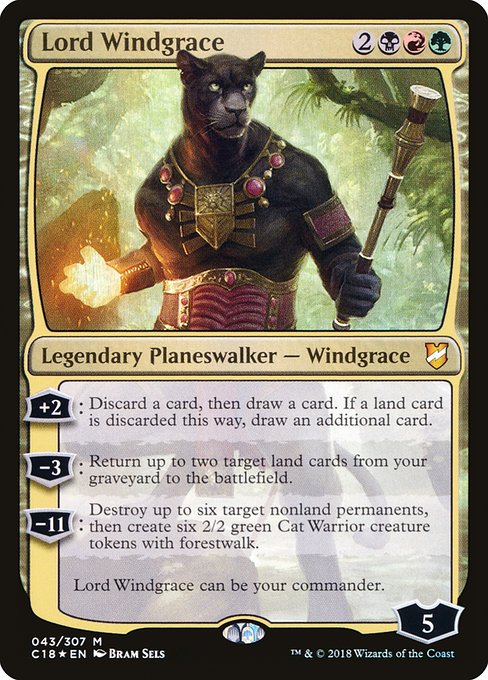


Jund land decks have been extremely popular since the printing of Lord Windgrace in Commander 2018, and isn’t particularly difficult to see why.
Card draw and mana ramp are both readily accessible with this planeswalker in your command zone, and as cards like Soul of Windgrace and Wrenn and Six have joined favorites like The Gitrog Monster and fetchlands, the strategy has become incredibly potent and consistent over time.
Soul of Windgrace is an especially interesting addition, as its triggers are very reminiscent of the Titans from M11, but it goes considerably further by offering 3 extra abilities that can pad your life total, cycle through cards, or protect itself by spending mana and discarding lands to the graveyard.
These lands can not only be retrieved by Lord Windgrace, but are also accessible by cards like Crucible of Worlds and Ramunap Excavator, Splendid Reclamation, and Titania, Protector of Argoth to ensure you always have a chance to get them onto the battlefield.
Lands decks aren’t the only ways to build an interesting ramp deck in Jund anymore though. Ognis, the Dragon’s Lash brings a much more aggressive approach to the table, acting as a “haste matters” commander and translating that into Treasure tokens just for attacking.
If you don’t want to look too hard for creatures that inherently have haste, this also isn’t a problem, as you can simply give all of them haste with cards like Fervor, Concordant Crossroads, Rhythm of the Wild, or Fires of Yavimaya, making construction of a deck revolving around this card or Ognis’s inclusion in a similarly aggressive deck quite manageable.
Best Jeskai Mana Ramp Card (Kykar, Wind’s Fury)
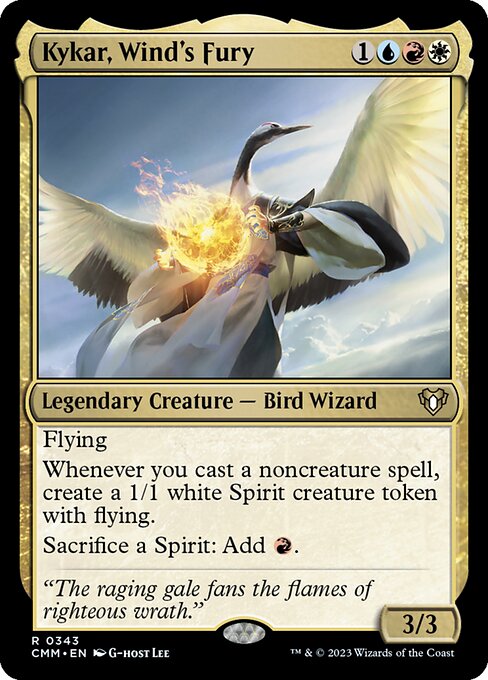
We’ve already touched on how good cards like Birgi, God of Storytelling or Storm-Kiln Artist are when you want to chain together multiple spells in a turn, and Kykar, Wind’s Fury brings similar potential to decks that revolve around noncreature spells while also giving you the choice to whittle away life totals by attacking with 1/1 flyers if you don’t need extra mana.
Unlike the other two cards, however, Kykar also works well as the head of a deck with Spirit creatures or other ways to make Spirit tokens, as Kykar’s ability to trade Spirits for red mana isn’t strictly limited to the tokens it creates.
This opens up some fairly creative options for mana acceleration if you want to build around big spell payoffs while leaving the option to build as a token deck intact. Otherwise, Kykar is typically best in combo decks that will be able to take advantage of the value generated by playing a lot of spells until you can go infinite or win through a mass of 1/1s.
Best Mardu Mana Ramp Card (Jan Jansen, Chaos Crafter)

Jan Jansen, Chaos Crafter is kind of a weird card to find in Mardu colors. Red, white, and black have all had varying degrees of artifact support over the years, but this legendary creature really ties together the reanimation, Trash for Treasure effects, and death trigger possibilities by providing a sacrifice outlet that also gradually increases your Treasures and creature tokens.
Mix in some effects that allow you to untap this legendary creature, and you’ve got an interesting build around commander. If you were already playing an artifact heavy reanimator deck in these colors, Jan Jansen, Chaos Crafter is also right at home in those builds too, but I’ll be honest, I have yet to see a deck like the one this card enables.
Best 4 Color Mana Ramp Card (Omnath, Locus of Creation)
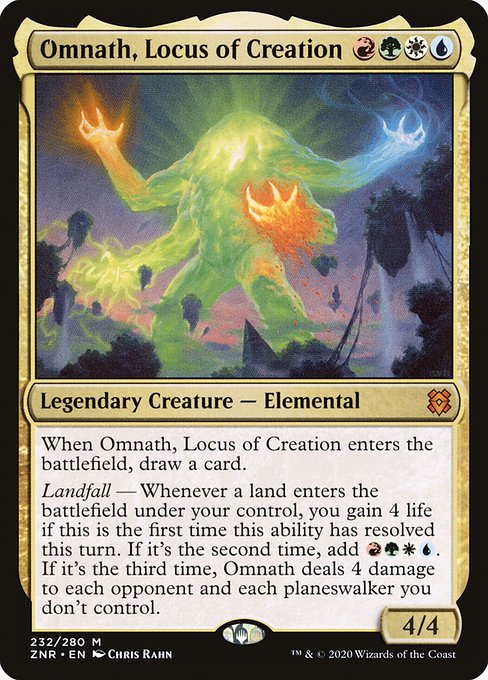
Omnath, Locus of Creation is an absolutely insane Magic card. With access to 4 colors, there are an absolute ton of ways to get multiple lands onto the battlefield each turn, sometimes even at instant speed, meaning something as innocent as a Harrow can suddenly turn into 4 life and a combat trick or two.
If you’re able to get 3 lands onto the battlefield during a given turn, Omnath will also do 4 damage to your opponents (and their planeswalkers, but not mean planeswalkers see mainstream Commander play), allowing you to whittle down life totals without having to make a single attack.
Very much a build around card, but the mana it generates is unreal – especially if you can get around the legend rule with cards like Mirror Box or Sakashima of a Thousand Faces. Don’t believe me? Check out this Extra Turns game over on the Command Zone’s YouTube channel.
Best 5 Color Mana Ramp Cards (Esika, God of the Tree, Fallaji Wayfarer, Jegantha, the Wellspring)
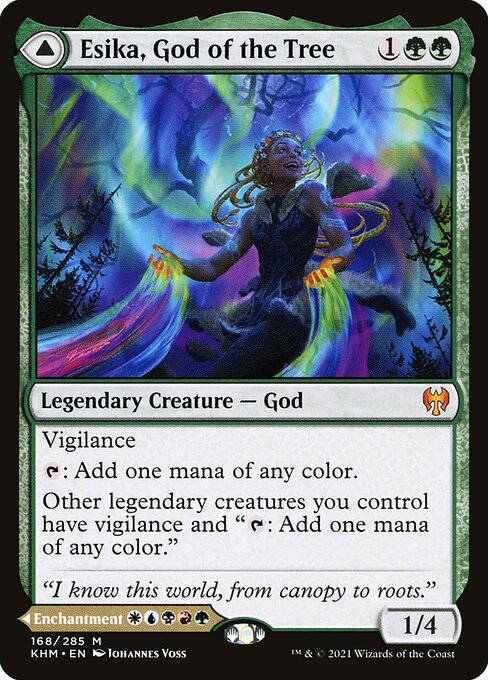
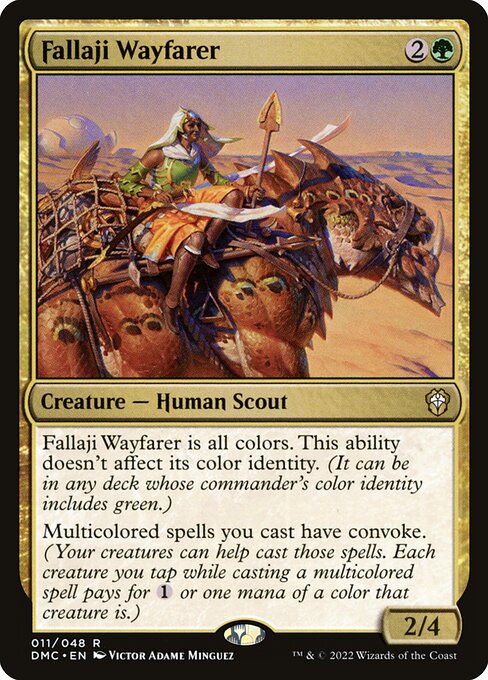

Good 5 color mana ramp options are tricky because they tend to cost at least 5 mana to include all 5 of Magic’s colors. That said, there are ways to work around that when the concept of color identity (the mana symbols on a card, including its effects) enters the picture.
Esika, God of the Tree makes itself a surprisingly affordable 3 drop by being a double-faced card with a 5 color mana cost on the back. Once it is in play, your legendary creatures become Birds of Paradise with Vigilance tacked on, allowing you to attack before tapping them to make mana of any color during your second main phase.
While this is a solid build around concept, Esika is also a great support card for commanders that care about legendary permanents like Sisay, Weatherlight Captain. And if you don’t need that extra boost in mana, The Prismatic Bridge can just put a creature or planeswalker from your deck into play during each of your upkeeps for free. Now that’s good value!
Fallaji Wayfarer takes a different approach, baking its colors and color identity into its first effect. Convoke is an incredibly powerful ability, as it lets any creature tap to reduce the cost of a card, and Fallaji just gives it to every multicolor spell you want to cast. Best of all, since its color identity is green, this works well in any deck playing both green and lots of multicolored cards.
But what if you want to guarantee you can draw your mana ramp card when you need it? Well, thanks to the extremely overpowered Companion mechanic, you can do that via Jegantha, the Wellspring. While the deckbuilding restriction won’t let you put every multicolored card you might want into your deck, Magic’s card pool is large enough to make it trivial.
Once it’s set up as a companion, all you need to do is pay 3 mana as a sorcery to put Jegantha into your hand – something you can usually find time to do once you have access to 3 or 4 mana. After that, you can play a 5/5 that taps for 5, and while it can’t pay for generic costs, knocking out colored mana costs will still put you far ahead – even if you only use 3-4 mana.
If you would rather not restrict your deckbuilding, Jegantha is also a solid card in the 99 of any 5 color deck playing a lot of 3+ color spells. While 5 mana is a lot to ask from a ramp spell, tapping for 5 mana while still getting a 5/5 is too good a rate to pass up much of the time.
Is Multicolor Mana Ramp Good?
This is an incredibly loaded question that can have several answers. Here are the general rules of thumb I follow when addressing this question myself:
- If my deck has green, the best mono green mana ramp spells are usually better than my multicolor options. If I need more mana ramp beyond those, then I’ll look at multicolor mana ramp.
- The primary exception to this rule is if I have access to Simic’s blue/green mana ramp cards. Simic’s best cards are potent enough to be top picks when considering mana ramp for a green/blue deck.
- If I have access to the best mana rocks for my Commander deck, I should usually prioritize those over any situational ramp spells, but use my best judgment when comparing them against my best mana ramp options.
- Does my deck or commander revolve around a specific theme that can consistently benefit from situationally good mana ramp? If so, I should prioritize cards that either enable that theme or can consistently outperform any generically powerful mana ramp options in my deck.
From there, I pick out the cards I find most likely to perform well in my deck, playtest, and then adjust as needed for my playgroup. This usually results in a pile of 6-10 cards, more if my deck needs a lot of mana to get going, less if I don’t have access to a lot of good options and am trying not to replace too many of my lands with mana rocks.
How you answer these questions will vary based on your playstyle and deck, so don’t be afraid to experiment until you find a blend of mana ramp cards that works for you. If the cards listed here don’t meet your needs, I also recommend searching through Scryfall or Gatherer – you might find a gem that’s perfect for your deck’s specific strategy.
Other MTG Articles You Might Enjoy
- Best Token Commanders MTG
- Best Dual Lands MTG Commander
- MTG Red Mana Ramp Commander
- MTG Black Mana Ramp Commander
Braden is a founder of Assorted Meeples and has been a gamer & writer with a vivid imagination all his life. Don’t believe us? Check out his excitement when meeting Goosebumps author R.L. Stine as a kid! An avid Magic: The Gathering spellslinger for over 15 years, you can always convince him to shuffle up for a game (or three!) of Commander.
